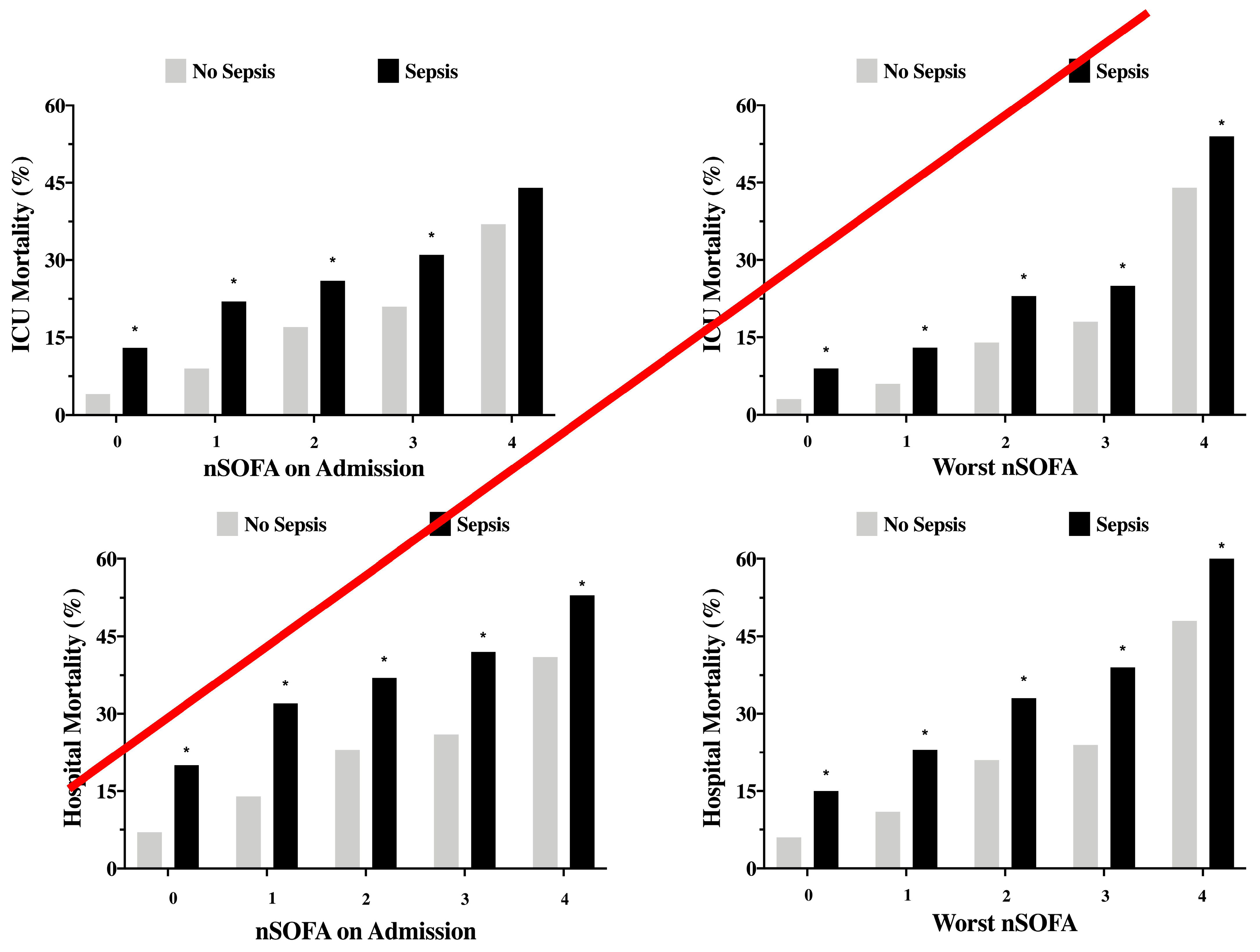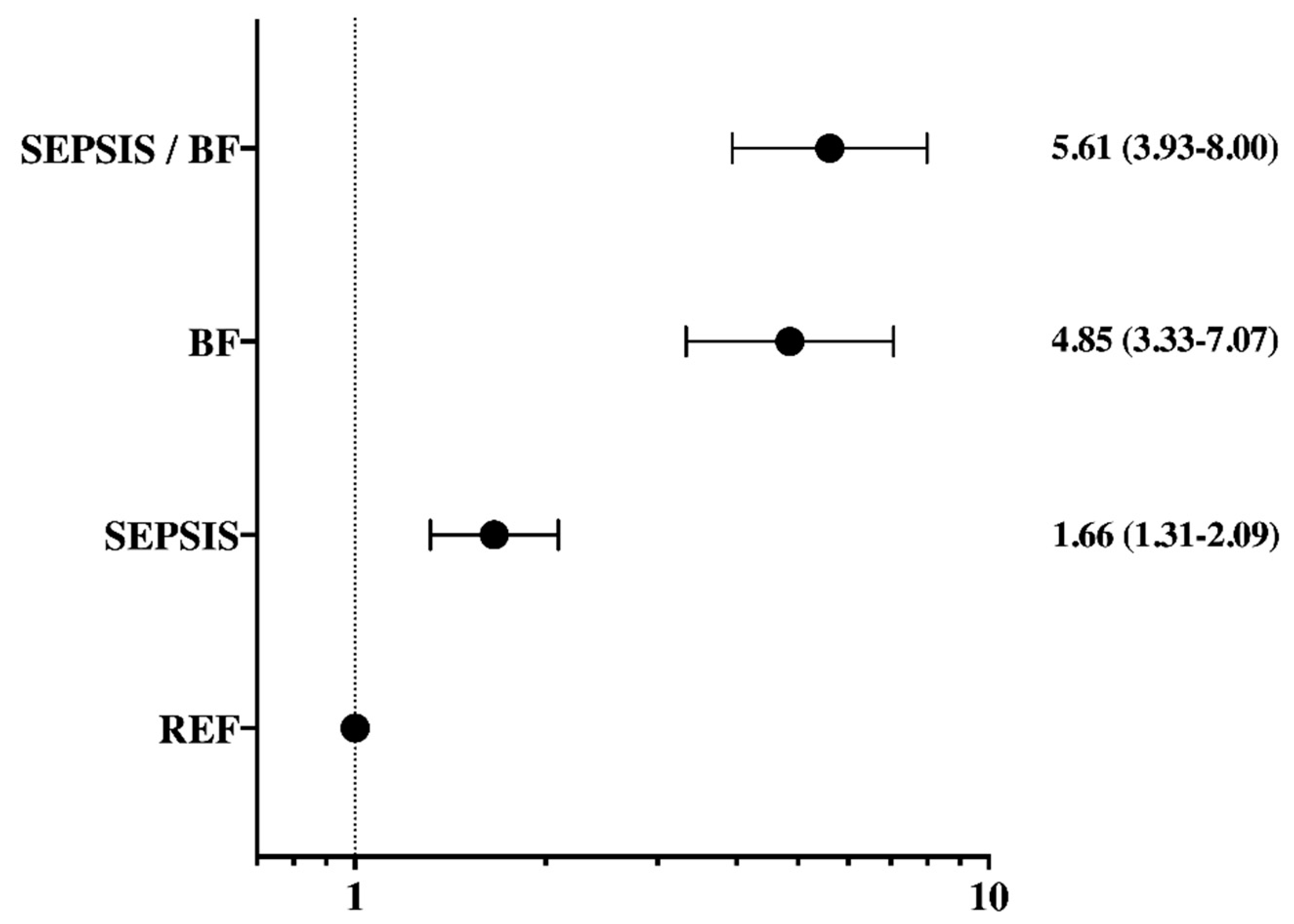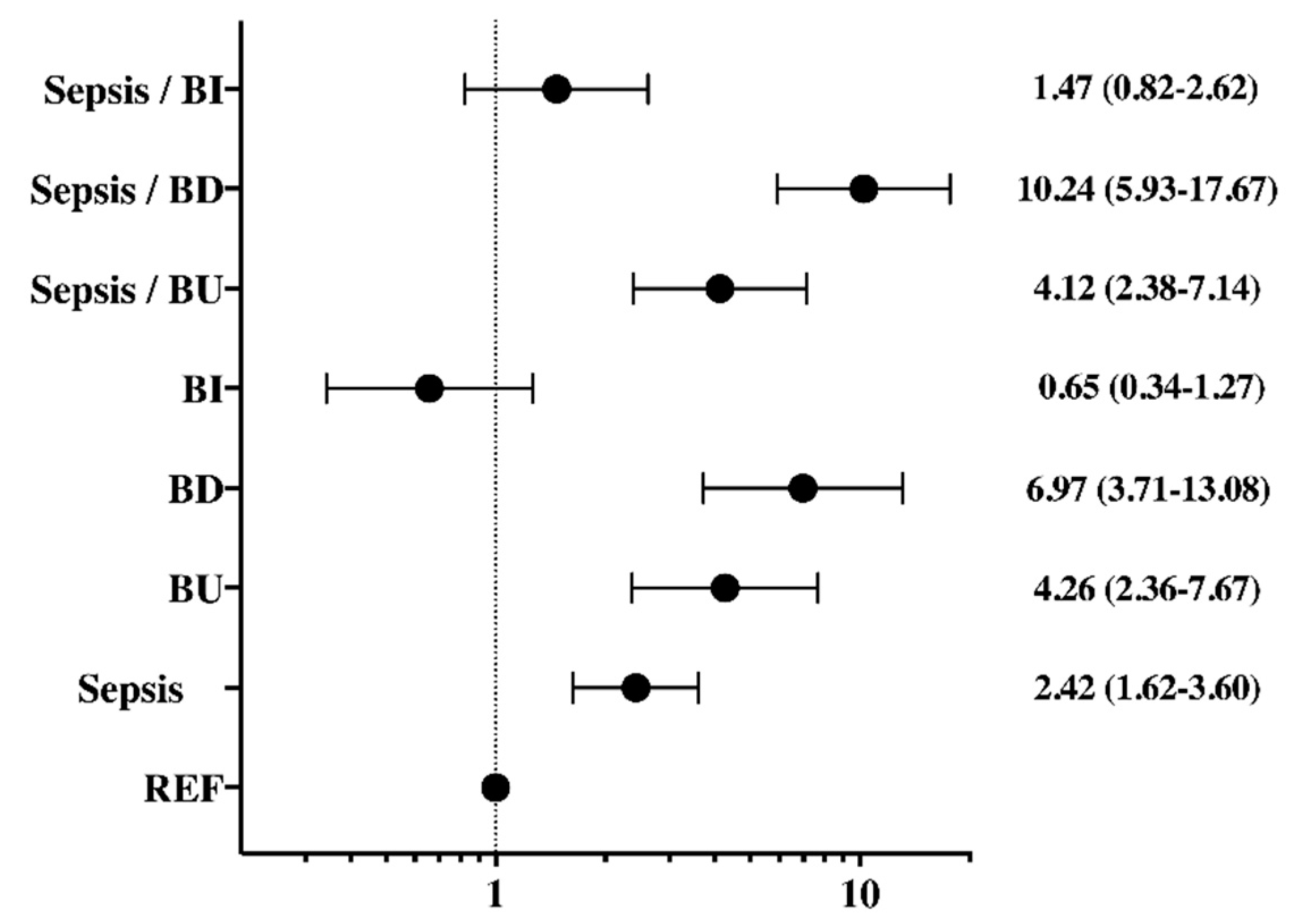The Prognostic Value of Brain Dysfunction in Critically Ill Patients with and without Sepsis: A Post Hoc Analysis of the ICON Audit
Abstract
:1. Introduction
2. Materials and Methods
2.1. Study Design
2.2. Data Management
2.3. Definitions
2.4. Statistical Analysis
3. Results
3.1. Neurological Function and Outcome
3.2. Evolution of Neurological Function and Outcome
4. Discussion
5. Conclusions
Supplementary Materials
Author Contributions
Funding
Institutional Review Board Statement
Informed Consent Statement
Data Availability Statement
Acknowledgments
Conflicts of Interest
References
- Bleck, T.P.; Smith, M.C.; Pierre-Louis, S.J.; Jares, J.J.; Murray, J.; Hansen, C.A. Neurologic complications of critical medical illnesses. Crit. Care Med. 1993, 21, 98–103. [Google Scholar] [CrossRef]
- Semmler, A.; Widmann, C.N.; Okulla, T.; Urbach, H.; Kaiser, M.; Widman, G.; Mormann, F.; Weide, J.; Fliessbach, K.; Hoeft, A.; et al. Persistent cognitive impairment, hippocampal atrophy and EEG changes in sepsis survivors. J. Neurol. Neurosurg. Psychiatry 2013, 84, 62–69. [Google Scholar] [CrossRef] [Green Version]
- Sprung, C.L.; Peduzzi, P.N.; Shatney, C.H.; Schein, R.M.; Wilson, M.F.; Sheagren, J.N.; Hinshaw, L.B. Impact of encephalopathy on mortality in the sepsis syndrome. The Veterans Administration Systemic Sepsis Cooperative Study Group. Crit. Care Med. 1990, 18, 801–806. [Google Scholar] [CrossRef]
- Gofton, T.E.; Young, G.B. Sepsis-associated encephalopathy. Nat. Rev. Neurol. 2012, 8, 557–566. [Google Scholar] [CrossRef] [PubMed]
- Papadopoulos, M.C.; Davies, D.C.; Moss, R.F.; Tighe, D.; Bennett, E.D. Pathophysiology of septic encephalopathy: A review. Crit. Care Med. 2000, 28, 3019–3024. [Google Scholar] [CrossRef]
- Bolton, C.F.; Young, G.B. Managing the nervous system effects of sepsis. Chest 2007, 131, 1273–1274. [Google Scholar] [CrossRef] [PubMed]
- Heming, N.; Mazeraud, A.; Verdonk, F.; Bozza, F.A.; Chretien, F.; Sharshar, T. Neuroanatomy of sepsis-associated encephalopathy. Crit. Care 2017, 21, 65. [Google Scholar] [CrossRef] [Green Version]
- Zhang, L.N.; Wang, X.T.; Ai, Y.H.; Guo, Q.L.; Huang, L.; Liu, Z.Y.; Yao, B. Epidemiological features and risk factors of sepsis-associated encephalopathy in intensive care unit patients: 2008–2011. Chin. Med. J. 2012, 125, 828–831. [Google Scholar] [PubMed]
- Eidelman, L.A.; Putterman, D.; Putterman, C.; Sprung, C.L. The spectrum of septic encephalopathy. Definitions, etiologies, and mortalities. JAMA 1996, 275, 470–473. [Google Scholar] [CrossRef]
- Sonneville, R.; de Montmollin, E.; Poujade, J.; Garrouste-Org, M.; Souweine, B.; Darmon, M.; Mariotte, E.; Argaud, L.; Barbier, F.; Goldgran-Toledano, D.; et al. Potentially modifiable factors contributing to sepsis-associated encephalopathy. Intensive Care Med. 2017, 43, 1075–1084. [Google Scholar] [CrossRef]
- Vincent, J.L.; Marshall, J.C.; Namendys-Silva, S.A.; Francois, B.; Martin-Loeches, I.; Lipman, J.; Reinhart, K.; Antonelli, M.; Pickkers, P.; Njimi, H.; et al. Assessment of the worldwide burden of critical illness: The Intensive Care Over Nations (ICON) audit. Lancet Respir. Med. 2014, 2, 380–386. [Google Scholar] [CrossRef]
- Vincent, J.L.; Moreno, R.; Takala, J.; Willatts, S.; De Mendonca, A.; Bruining, H.; Reinhart, C.K.; Suter, P.M.; Thijs, L.G. The SOFA (Sepsis-related Organ Failure Assessment) score to describe organ dysfunction/failure. On behalf of the Working Group on Sepsis-Related Problems of the European Society of Intensive Care Medicine. Intensive Care Med. 1996, 22, 707–710. [Google Scholar] [CrossRef]
- Knox, D.B.; Lanspa, M.J.; Kuttler, K.G.; Brewer, S.C.; Brown, S.M. Phenotypic clusters within sepsis-associated multiple organ dysfunction syndrome. Intensive Care Med. 2015, 41, 814–822. [Google Scholar] [CrossRef] [Green Version]
- Blanco, J.; Muriel-Bombin, A.; Sagredo, V.; Taboada, F.; Gandia, F.; Tamayo, L.; Collado, J.; Garcia-Labattut, A.; Carriedo, D.; Valledor, M.; et al. Incidence, organ dysfunction and mortality in severe sepsis: A Spanish multicentre study. Crit. Care 2008, 12, R158. [Google Scholar] [CrossRef] [Green Version]
- Moreno, R.P.; Metnitz, B.; Adler, L.; Hoechtl, A.; Bauer, P.; Metnitz, P.G. Sepsis mortality prediction based on predisposition, infection and response. Intensive Care Med. 2008, 34, 496–504. [Google Scholar] [CrossRef] [Green Version]
- Ely, E.W.; Margolin, R.; Francis, J.; May, L.; Truman, B.; Dittus, R.; Speroff, T.; Gautam, S.; Bernard, G.R.; Inouye, S.K. Evaluation of delirium in critically ill patients: Validation of the Confusion Assessment Method for the Intensive Care Unit (CAM-ICU). Crit. Care Med. 2001, 29, 1370–1379. [Google Scholar] [CrossRef] [PubMed]
- Bergeron, N.; Dubois, M.J.; Dumont, M.; Dial, S.; Skrobik, Y. Intensive Care Delirium Screening Checklist: Evaluation of a new screening tool. Intensive Care Med. 2001, 27, 859–864. [Google Scholar] [CrossRef] [PubMed]
- Ely, E.W.; Shintani, A.; Truman, B.; Speroff, T.; Gordon, S.M.; Harrell, F.E., Jr.; Inouye, S.K.; Bernard, G.R.; Dittus, R.S. Delirium as a predictor of mortality in mechanically ventilated patients in the intensive care unit. JAMA 2004, 291, 1753–1762. [Google Scholar] [CrossRef] [PubMed] [Green Version]
- Ferreira, F.L.; Bota, D.P.; Bross, A.; Melot, C.; Vincent, J.L. Serial evaluation of the SOFA score to predict outcome in critically ill patients. JAMA 2001, 286, 1754–1758. [Google Scholar] [CrossRef] [Green Version]
- van den Boogaard, M.; Kox, M.; Quinn, K.L.; van Achterberg, T.; van der Hoeven, J.G.; Schoonhoven, L.; Pickkers, P. Biomarkers associated with delirium in critically ill patients and their relation with long-term subjective cognitive dysfunction; indications for different pathways governing delirium in inflamed and noninflamed patients. Crit. Care 2011, 15, R297. [Google Scholar] [CrossRef] [PubMed] [Green Version]
- Gorji, M.A.; Gorji, A.M.; Hosseini, S.H. Which score should be used in intubated patients’ Glasgow coma scale or full outline of unresponsiveness? Int. J. Appl. Basic Med. Res. 2015, 5, 92–95. [Google Scholar] [PubMed] [Green Version]
- Xing, X.Z.; Gao, Y.; Wang, H.J.; Qu, S.N.; Huang, C.L.; Zhang, H.; Wang, H.; Xiao, Q.L.; Sun, K.L. Effect of sedation on short-term and long-term outcomes of critically ill patients with acute respiratory insufficiency. World J. Emerg. Med. 2015, 6, 147–152. [Google Scholar] [CrossRef] [PubMed] [Green Version]



| Admission nSOFA | Day 3 nSOFA | ΔnSOFA | Brain Condition |
|---|---|---|---|
| 0 | 0 | 0 | unchanged |
| 0 | 1/2/3/4 | 1/2/3/4 | deterioration |
| 1 | 0 | −1 | improvement |
| 1 | 1 | 0 | unchanged |
| 1 | 2/3/4 | 1/2/3 | deterioration |
| 2 | 0/1 | −2/−1 | improvement |
| 2 | 2 | 0 | unchanged |
| 2 | 3/4 | 1/2 | deterioration |
| 3 | 0/1 | −3/−2 | improvement |
| 3 | 2/3/4 | −1/0/1 | unchanged |
| 4 | 0/1/2 | −4/−3/−2 | improvement |
| 4 | 3/4 | −1/0 | unchanged |
| Sepsis | No Sepsis | p Value | |
|---|---|---|---|
| Age (years) | 61 (±17) (n = 2089) | 60 (±18) (n = 5054) | <0.001 |
| SAPS II score | 46 (±17) | 35 (±17) | <0.001 |
| SOFA score | 7 (±4) | 5 (±4) | <0.001 |
| ICU LOS (days) | 4 [2–9] (n = 2036) | 2 [1–4] (n = 4803) | <0.001 |
| Hospital LOS (days) | 12 [6–25] (n = 2001) | 8 [4–14] (n = 4557) | <0.001 |
| Male, n/total (%) | 2989/5020 (60) | 1227/2079 (59) | 0.7 |
| Type of admission | (n = 2006) | (n = 4769) | |
| ● Medical | 1290 (64) | 2605 (55) | <0.001 |
| ● Surgical | 663 (33) | 1902 (40) | <0.001 |
| ● Trauma | 45 (2) | 229 (5) | <0.001 |
| Admission source | |||
| ● Operating room | 308 (15) | 1085 (21) | <0.001 |
| ● Emergency room | 689 (33) | 1851 (36) | 0.006 |
| ● Other hospital | 200 (10) | 431 (9) | 0.14 |
| ● Same hospital | 745 (36) | 1211 (24) | <0.001 |
| COPD | 355 (17) | 578 (11) | <0.001 |
| Cancer | 264 (13) | 533 (11) | 0.009 |
| ● Metastatic | 97 (5) | 157 (3) | 0.002 |
| ● Hematological | 81 (4) | 77 (2) | <0.001 |
| Diabetes mellitus | 257 (12) | 502 (10) | 0.003 |
| Liver cirrhosis | 105 (5) | 170 (3) | 0.001 |
| Immunodepression | 145 (7) | 130 (3) | <0.001 |
| Artificial airway | |||
| ● On admission | 1092 (52) | 1729 (34) | <0.001 |
| ● During ICU stay | 1293 (62) | 1886 (37) | <0.001 |
| Mechanical ventilation | |||
| ● On admission | 1192 (57) | 1823 (36) | <0.001 |
| ● During ICU stay | 1382 (66) | 2000 (39) | <0.001 |
| Renal replacement therapy | |||
| ● On admission | 342 (11) | 261 (5) | <0.001 |
| ● During ICU stay | 570 (27) | 518 (10) | <0.001 |
| Organ failure on admission | |||
| ● Respiratory | 670 (32) | 706 (14) | <0.001 |
| ● Coagulation | 179 (9) | 309 (6) | <0.001 |
| ● Hepatic | 299 (14) | 438 (9) | <0.001 |
| ● Neurological | 434 (21) | 617 (12) | <0.001 |
| ● Renal | 517 (25) | 959 (19) | <0.001 |
| ● Circulatory | 830 (40) | 941 (19) | <0.001 |
| Organ failure during ICU stay | |||
| ● Respiratory | 961 (46) | 947 (19) | <0.001 |
| ● Coagulation | 358 (17) | 454 (9) | <0.001 |
| ● Hepatic | 641 (31) | 841 (17) | <0.001 |
| ● Neurological | 625 (30) | 736 (14) | <0.001 |
| ● Renal | 1143 (55) | 2144 (42) | <0.001 |
| ● Circulatory | 1064 (51) | 1163 (23) | <0.001 |
| ICU mortality according to admission nSOFA * | |||
| ● nSOFA = 0 | 139/1075 (13) | 125/3063 (4) | <0.001 |
| ● nSOFA = 1 | 72/323 (22) | 49/546 (9) | <0.001 |
| ● nSOFA = 2 | 63/240 (26) | 56/327 (17) | 0.006 |
| ● nSOFA = 3 | 62/200 (31) | 59/282 (21) | 0.008 |
| ● nSOFA = 4 | 98/225 (44) | 118/320 (37) | 0.07 |
| ICU mortality according to maximum nSOFA * | |||
| ● nSOFA = 0 | 75/877 (9) | 82/2849 (3) | <0.001 |
| ● nSOFA = 1 | 43/326 (13) | 37/625 (6) | <0.001 |
| ● nSOFA = 2 | 56/246 (23) | 49/345 (14) | 0.005 |
| ● nSOFA = 3 | 61/242 (25) | 55/304 (18) | 0.03 |
| ● nSOFA = 4 | 199/372 (54) | 184/415 (44) | 0.006 |
| Hospital mortality according to admission nSOFA ** | |||
| ● nSOFA = 0 | 207/1038 (20) | 212/2917 (7) | <0.001 |
| ● nSOFA = 1 | 101/315 (32) | 74/529 (14) | <0.001 |
| ● nSOFA = 2 | 85/232 (37) | 71/311 (23) | <0.001 |
| ● nSOFA = 3 | 82/194 (42) | 70/275 (26) | <0.001 |
| ● nSOFA = 4 | 117/221 (53) | 128/312 (41) | 0.004 |
| Hospital mortality according to maximum nSOFA ** | |||
| ● nSOFA = 0 | 125/845 (15) | 153/2710 (6) | <0.001 |
| ● nSOFA = 1 | 71/315 (23) | 66/606 (11) | <0.001 |
| ● nSOFA = 2 | 78/236 (33) | 69/326 (21) | 0.001 |
| ● nSOFA = 3 | 93/236 (39) | 71/297 (24) | <0.001 |
| ● nSOFA = 4 | 225/368 (61) | 196/405 (48) | <0.001 |
Publisher’s Note: MDPI stays neutral with regard to jurisdictional claims in published maps and institutional affiliations. |
© 2021 by the authors. Licensee MDPI, Basel, Switzerland. This article is an open access article distributed under the terms and conditions of the Creative Commons Attribution (CC BY) license (https://creativecommons.org/licenses/by/4.0/).
Share and Cite
Crippa, I.A.; Taccone, F.S.; Wittebole, X.; Martin-Loeches, I.; Schroeder, M.E.; François, B.; Kotfis, K.; Ñamendys-Silva, S.A.; Forceville, X.; Solé-Violán, J.; et al. The Prognostic Value of Brain Dysfunction in Critically Ill Patients with and without Sepsis: A Post Hoc Analysis of the ICON Audit. Brain Sci. 2021, 11, 530. https://doi.org/10.3390/brainsci11050530
Crippa IA, Taccone FS, Wittebole X, Martin-Loeches I, Schroeder ME, François B, Kotfis K, Ñamendys-Silva SA, Forceville X, Solé-Violán J, et al. The Prognostic Value of Brain Dysfunction in Critically Ill Patients with and without Sepsis: A Post Hoc Analysis of the ICON Audit. Brain Sciences. 2021; 11(5):530. https://doi.org/10.3390/brainsci11050530
Chicago/Turabian StyleCrippa, Ilaria A., Fabio S. Taccone, Xavier Wittebole, Ignacio Martin-Loeches, Mary E. Schroeder, Bruno François, Katarzyna Kotfis, Silvio A. Ñamendys-Silva, Xavier Forceville, Jordi Solé-Violán, and et al. 2021. "The Prognostic Value of Brain Dysfunction in Critically Ill Patients with and without Sepsis: A Post Hoc Analysis of the ICON Audit" Brain Sciences 11, no. 5: 530. https://doi.org/10.3390/brainsci11050530
APA StyleCrippa, I. A., Taccone, F. S., Wittebole, X., Martin-Loeches, I., Schroeder, M. E., François, B., Kotfis, K., Ñamendys-Silva, S. A., Forceville, X., Solé-Violán, J., Fontes, L. E., Vincent, J.-L., & on behalf of the ICON Investigators. (2021). The Prognostic Value of Brain Dysfunction in Critically Ill Patients with and without Sepsis: A Post Hoc Analysis of the ICON Audit. Brain Sciences, 11(5), 530. https://doi.org/10.3390/brainsci11050530








